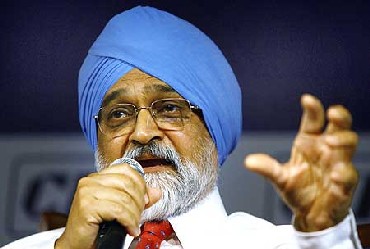 | « Back to article | Print this article |
It's not jobless growth, show official data
Claiming that there has been a 'gross misrepresentation' of the National Sample Survey Organisation (NSSO) data, Planning Commission Deputy Chairman Montek Singh Ahluwalia said, "We need to have a better understanding of statistics to correctly interpret statistical findings like the NSSO employment survey."
According to principal advisor with the Planning Commission and former chief statistician, Pronob Sen, there were 40-45 million more people in the age group of 15-59 between 2004-05 and 2009-10. The unemployment rate has correspondingly fallen from 2.3 per cent to 2 per cent of the labour force.
"It means the additional people in the working-age population were given jobs and some past unemployed people also got jobs (They) may not be (getting) remunerative wages," Sen said.
Click NEXT to read more...
It's not jobless growth, show official data
The unemployment rate ('usual status activity' in technical jargon) is computed, as the number of people in the age group of 15-59 who are willing to work but did not obtain, paid employment for at least 180 days during the past 365 days.
The latest NSSO survey was conducted between July 2009 and June 2010 and included a sample of over 100,000 households.
"The usual status activity is a poor indicator of the employment rate, but is a reliable indicator when it comes to knowing whether workers are finding jobs or not. For example, between 2004-05 and 2009-10, the working-age population grew by an average of two per cent per year, which is about 8-9 million individuals. They all got some jobs, as did few people previously unemployed," said Sen.
Click NEXT to read more...
It's not jobless growth, show official data
What then explains the decline in the Worker's Population Ratio (WPR) from 42 per cent to 39.2 per cent during this period? Sen ascribes this decline to the rise in the ratio of enrolment in post-secondary school classes.
Staying longer in schools delays the entry into the workforce because students are not really looking for work during this period.
Sen's explanation is enthusiastically corroborated by Chief Statistician T C A Anant, "A declining WPR is a positive indicator as it shows an increase in the number opting for higher education which means we will have a skilled workforce in the future".
This decline is also reflected in the declining Labour force Participation Rate (LFPR), a measure of the number of working-age population either employed or willing to work.
The three percentage point fall in LFPR between 2004-05 and 2009-10 could have to do with more than mere structural factors.
Click NEXT to read more...
It's not jobless growth, show official data
For example, rural women working in agriculture or animal husbandry consider their contributions simply as part of household work and not employment.
This probably results in an underestimation of the actual size of the labour market, a problem that can be largely overcome by better training and cultural sensitization of the survey staff to ask the right follow up questions.
Sen recalled that when he was chief statistician and secretary in the Ministry of Statistics and Programme Implementation, there were 1,200-1,300 vacancies for the survey staff.
"As many as 900 contract investigators were hired. They don't have enough experience to ask follow up questions."




